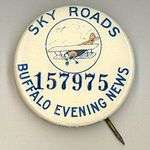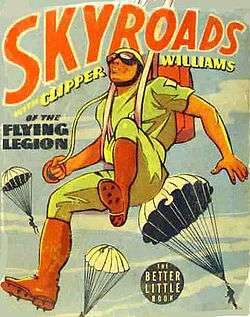Skyroads (comics)


Skyroads, a serialized aviation-based comic strip, was published from 1929 to 1942.
After Charles Lindbergh's crossing of the Atlantic Ocean, aviation became the focus of several comic strips. Tailspin Tommy was the first, but it was soon followed by others, including Skyroads.[1][2]
Skyroads was created by aviation pioneer Lester J. Maitland and Lt. Dick Calkins, an ex-Army Air Service pilot who later drew the Buck Rogers comic strip. Maitland and Calkins continued to collaborate on Skyroads until 1933, when Calkins' assistant, Russell Keaton, took over the writing and artwork. Keaton remained until the end of the series.[1]
Characters and story
Unlike other serialized comic strips, Skyroads did not have a single focal character over the course of its printing run. Instead, it focused on aviation as a whole, telling different stories with a different set of characters every few years. Three distinctive periods appeared over the publication history of Skyroads, each with its own defined set of characters. The first featured were Ace Ames and Buster Evans who owned and operated the Skyroads Unlimited transport company. This duo was followed by Hurricane Hawk and then Speed McCloud.[1]
Clipper Williams, a member of the Flying Legion, soared into air adventures with his kid sidekick, Tommy. Eventually, the Flying Legion became the focus instead of Clipper Williams, a plot situation that remained until the series concluded in 1942.[1]
Radio and books
On February 13, 1939, the Mutual Broadcasting System began a radio adaptation of Skyroads that ran four months and came to a conclusion on May 19. Two Better Little Books were published (1936, 1939) with the Skyroads characters. A brief return occurred in the 1960s with reprints in a saddle-stitched magazine format by publisher Edwin Aprill. However, only one volume was published by Aprill.[1]